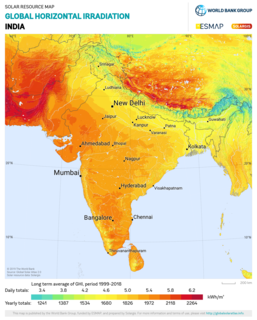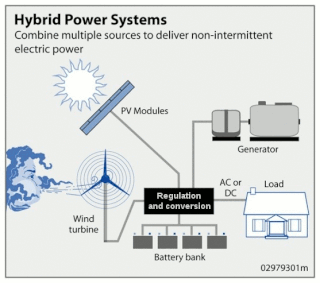Related Research Articles

India is the world's third largest producer and third largest consumer of electricity. The national electric grid in India has an installed capacity of 383.37 GW as of 31 May 2021. Renewable power plants, which also include large hydroelectric plants, constitute 37% of India's total installed capacity. During the fiscal year (FY) 2019-20, the gross electricity generated by utilities in India was 1,383.5 TWh and the total electricity generation in the country was 1,598 TWh. The gross electricity consumption in FY2019 was 1,208 kWh per capita. In FY2015, electric energy consumption in agriculture was recorded as being the highest (17.89%) worldwide. The per capita electricity consumption is low compared to most other countries despite India having a low electricity tariff.

Peaking power plants, also known as peaker plants, and occasionally just "peakers", are power plants that generally run only when there is a high demand, known as peak demand, for electricity. Because they supply power only occasionally, the power supplied commands a much higher price per kilowatt hour than base load power. Peak load power plants are dispatched in combination with base load power plants, which supply a dependable and consistent amount of electricity, to meet the minimum demand.
The energy policy of India is largely defined by the country's expanding energy deficit and increased focus on developing alternative sources of energy, particularly nuclear, solar and wind energy. India attained 63% overall energy self-sufficiency in 2017.

The Ministry of New and Renewable Energy (MNRE) is a ministry of the Government of India, headed by Minister of State Raj Kumar Singh, that is mainly responsible for research and development, intellectual property protection, and international cooperation, promotion, and coordination in renewable energy sources such as wind power, small hydro, biogas, and solar power.

Solar power in India is a fast developing industry. The country's solar installed capacity was 36.9 GW as of 30 November 2020.
For solar power, South Asia has the ideal combination of both high solar insolation and a high density of potential customers.

Renewable energy in developing countries is an increasingly used alternative to fossil fuel energy, as these countries scale up their energy supplies and address energy poverty. Renewable energy technology was once seen as unaffordable for developing countries. However, since 2015, investment in non-hydro renewable energy has been higher in developing countries than in developed countries, and comprised 54% of global renewable energy investment in 2019. The International Energy Agency forecasts that renewable energy will provide the majority of energy supply growth through 2030 in Africa and Central and South America, and 42% of supply growth in China.

NHPC Limited is an Indian government hydropower board under the ownership of Ministry of Power, Government of India that was incorporated in the year 1975 with an authorised capital of Rs. 2000 million and with an objective to plan, promote and organise an integrated and efficient development of hydroelectric power in all aspects. Later on NHPC expanded its objects to include other sources of energy like Solar, Geothermal, Tidal, Wind etc.

As of 2019, renewable energy technologies provide about 17.3% of Canada's total primary energy supply. For electricity renewables provide 67%, with 15% from nuclear and 18% from hydrocarbons.

India is one of the countries with large production of energy from renewable sources. As of 27 November 2020, 38% of India's installed electricity generation capacity is from renewable sources.
Renewable energy in Tuvalu is a growing sector of the country's energy supply. Tuvalu has committed to sourcing 100% of its electricity from renewable energy. This is considered possible because of the small size of the population of Tuvalu and its abundant solar energy resources due to its tropical location. It is somewhat complicated because Tuvalu consists of nine inhabited islands. The Tuvalu National Energy Policy (TNEP) was formulated in 2009, and the Energy Strategic Action Plan defines and directs current and future energy developments so that Tuvalu can achieve the ambitious target of 100% renewable energy for power generation by 2020. The program is expected to cost 20 million US dollars and is supported by the e8, a group of 10 electric companies from G8 countries. The Government of Tuvalu worked with the e8 group to develop the Tuvalu Solar Power Project, which is a 40 kW grid-connected solar system that is intended to provide about 5% of Funafuti’s peak demand, and 3% of the Tuvalu Electricity Corporation's annual household consumption.

The electricity sector in Sri Lanka has a national grid which is primarily powered by hydroelectric power and thermal power, with sources such as photovoltaics and wind power in early stages of deployment. Although potential sites are being identified, other power sources such as geothermal, nuclear, solar thermal and wave power are not used in the power generation process for the national grid.

The Lebanese Center for Energy Conservation (LCEC) is the national energy agency for Lebanon. LCEC is a governmental organization affiliated to the Lebanese Ministry of Energy and Water (MEW). LCEC is the technical arm of the Ministry in all subjects related to energy efficiency, renewable energy, and green buildings. LCEC provides energy efficiency and renewable energy programs to the public and private sectors in Lebanon.

Wind hybrid power systems combines wind turbines with other storage and/or generation sources. One of the key issues with wind energy is its intermittent nature. This has led to numerous methods of storing energy.

Renewable energy in Afghanistan includes biomass, hydropower, solar, and wind power. Afghanistan is a landlocked country surrounded by five other countries. With a population of less than 35 million people, it is one of the lowest energy consuming countries in relation to a global standing. It holds a spot as one of the countries with a smaller ecological footprint. Hydropower is currently the main source of renewable energy due to Afghanistan's geographical location. Its large mountainous environment facilitates the siting of hydroelectric dams and other facets of hydro energy.
Concept of Smart villages is a global modern approach for off-grid communities. Vision behind this concept is to assist the policy makers, donors and socio-economic planner for rural electrification worldwide, with special focus on Asian and African countries. Smart villages concept is engaged in efforts to combat the real barriers to energy access in villages, particularly in developing countries with technological, financial and educational methodology. Since 20th Century Electricity has become a vital part of our lives, though we can survive without electricity but cannot progress and enjoy the benefits of science. World's large oil companies have predicted that by 2050, one third of the energy will need to come from Solar, Wind and other renewable resources, therefore adoption of renewable resource in place of fossil fuel is the best approach that can be developed through off-grid systems or communities.
Maharashtra Energy Development Agency - MEDA is a Maharashtra government institute run with the Federal Government of India, to regulate energy conservation and to promote the development of renewable energy in Maharashtra State, including solar energy, bio-energy and wind energy. MEDA is working as a State Nodal Agency (SNA) under the aegis of Energy Department, the State of Maharashtra. MEDA is also working as a State Designated Agency (SDA) for implementation of Bureau of Energy Efficiency (BEE),
There is enormous potential for renewable energy in Kazakhstan, particularly from wind and small hydropower plants. The Republic of Kazakhstan has the potential to generate 10 times as much power as it currently needs from wind energy alone. But renewable energy accounts for just 0.6 percent of all power installations. Of that, 95 percent comes from small hydropower projects. The main barriers to investment in renewable energy are relatively high financing costs and an absence of uniform feed-in tariffs for electricity from renewable sources. The amount and duration of renewable energy feed-in tariffs are separately evaluated for each project, based on feasibility studies and project-specific generation costs. Power from wind, solar, biomass and water up to 35 MW, plus geothermal sources, are eligible for the tariff and transmission companies are required to purchase the energy of renewable energy producers. An amendment that introduces and clarifies technology-specific tariffs is now being prepared. It is expected to be adopted by Parliament by the end of 2014. In addition, the World Bank's Ease of Doing Business indicator shows the country to be relatively investor-friendly, ranking it in 10th position for investor protection.
References
- 1 2 Duncan McKenzie (28 March 2013). "India's Off-grid Renewables Initiative Changing Lives". Renewable Energy World. Retrieved 11 November 2013.
- 1 2 3 Srinagar (5 September 2013). "Ladakh's giant leap in renewable energy". Kashmir Newz. Retrieved 11 November 2013.
- ↑ Jos Van Den Akker (January–February 2003). "Solar PV on Top of the World" (PDF). Renewable Energy World. Retrieved 11 November 2013.
- ↑ ANI (5 August 2011). "Sun-driven Ladakh". Yahoo News. Retrieved 11 November 2013.
- 1 2 Rasul Bailay, Kirtika Suneja (1 January 2012). "A solar revolution". The Financial Express. Retrieved 11 November 2013.
- ↑ "Ladakh Renewable Energy awarded "Excellence Award" by Renewtech India". Scoop News. 17 May 2013. Retrieved 11 November 2013.
- ↑ "UNDP-GEF AWARDS "lreda-lahdc-conferred-undp-gefs-award2013" by undp-gef". Scoop News. 20 December 2013. Retrieved 12 December 2013.